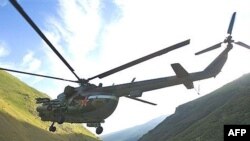Georgian Foreign Ministry official Zurab Kachkachishvili rejected on April 27 as a provocation Russian claims that the counterterrorism regime imposed in several districts of southeastern Chechnya last week was necessitated by the danger that Chechen militants currently based in Georgia might seek to cross the border into Chechnya to stage terrorist attacks there.
Russia's National Counterterrorism Committee announced on April 16 the official end of the counterterror operation launched in Chechnya by then-Russian President Boris Yeltsin 10 years earlier. But within days, the Russian military commandant's office in Chechnya announced the reimposition of counterterror restrictions in the Vedeno and Itum-Kale raions of southern Chechnya. Vedeno borders on Daghestan, while Itum-Kale, to the west of Vedeno, borders on Georgia.
A spokesman for the Russian military claimed on April 21 that up to 60 militants were amassed in Itum-Kale in readiness to stage a series of terrorist acts in the north of Chechnya. He said those militants had been trained in camps on Georgian territory.
The counterterror operation was subsequently extended to Shatoi Raion (directly north of Itum-Kale) and parts of Shali Raion, which lies northwest of Vedeno and southeast of Grozny. Vladimir Patrin, a spokesman for the operational headquarters of the Russian forces in Chechnya, told journalists on April 24 that the counterterror operation was extended to Shatoi and Shali in response to intelligence reports of planned terrorist attacks against government and law enforcement officials. The restrictions in Shali were lifted late on April 26; on April 28, an explosive device detonated in Shali as three police patrol cars drove by, but inflicted only minimal damage.
Kachkachishvili explicitly denied on April 27 that Chechen militants could enter Russia from the Pankisi Gorge, which in 2000-02 served as a safe haven for a group of Chechen militants led by field commander Ruslan Gelayev. He said international organizations have conducted repeated tours of inspection and can attest to the absence of militants in Pankisi. But he apparently did not specify when the last such tour of inspection took place.
It was to target that Chechen militant presence in Pankisi that the United States began its $64 million Train and Equip program for the Georgian military. Georgian forces launched two special operations to expel Chechen militants from Pankisi, in the fall of 2002 and early 2003, after which then-Georgian President Eduard Shevardnadze affirmed in February 2003 that there were no longer any Chechen fighters in Pankisi. Gelayev was killed in February 2004 in Daghestan, close to the border with Georgia.
Russian officials have, however, periodically claimed that groups of "gunmen" have resurfaced in Pankisi. Lieutenant General Anatoly Zabrodin, who heads the Border Protection Service of Russia's Federal Security Service (FSB), went public with such claims in January 2007, and again in February 2008. On both occasions, Georgian officials denied those allegations.
Russia's National Counterterrorism Committee announced on April 16 the official end of the counterterror operation launched in Chechnya by then-Russian President Boris Yeltsin 10 years earlier. But within days, the Russian military commandant's office in Chechnya announced the reimposition of counterterror restrictions in the Vedeno and Itum-Kale raions of southern Chechnya. Vedeno borders on Daghestan, while Itum-Kale, to the west of Vedeno, borders on Georgia.
A spokesman for the Russian military claimed on April 21 that up to 60 militants were amassed in Itum-Kale in readiness to stage a series of terrorist acts in the north of Chechnya. He said those militants had been trained in camps on Georgian territory.
The counterterror operation was subsequently extended to Shatoi Raion (directly north of Itum-Kale) and parts of Shali Raion, which lies northwest of Vedeno and southeast of Grozny. Vladimir Patrin, a spokesman for the operational headquarters of the Russian forces in Chechnya, told journalists on April 24 that the counterterror operation was extended to Shatoi and Shali in response to intelligence reports of planned terrorist attacks against government and law enforcement officials. The restrictions in Shali were lifted late on April 26; on April 28, an explosive device detonated in Shali as three police patrol cars drove by, but inflicted only minimal damage.
Kachkachishvili explicitly denied on April 27 that Chechen militants could enter Russia from the Pankisi Gorge, which in 2000-02 served as a safe haven for a group of Chechen militants led by field commander Ruslan Gelayev. He said international organizations have conducted repeated tours of inspection and can attest to the absence of militants in Pankisi. But he apparently did not specify when the last such tour of inspection took place.
It was to target that Chechen militant presence in Pankisi that the United States began its $64 million Train and Equip program for the Georgian military. Georgian forces launched two special operations to expel Chechen militants from Pankisi, in the fall of 2002 and early 2003, after which then-Georgian President Eduard Shevardnadze affirmed in February 2003 that there were no longer any Chechen fighters in Pankisi. Gelayev was killed in February 2004 in Daghestan, close to the border with Georgia.
Russian officials have, however, periodically claimed that groups of "gunmen" have resurfaced in Pankisi. Lieutenant General Anatoly Zabrodin, who heads the Border Protection Service of Russia's Federal Security Service (FSB), went public with such claims in January 2007, and again in February 2008. On both occasions, Georgian officials denied those allegations.




